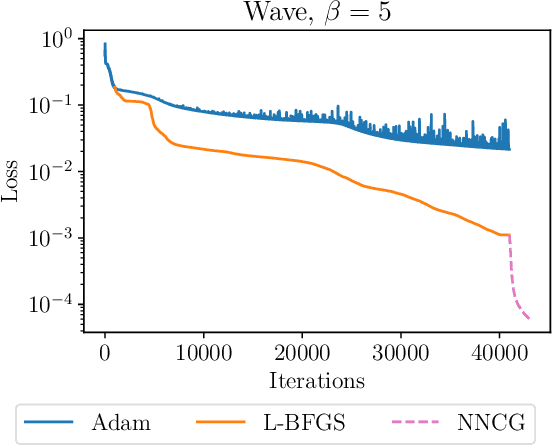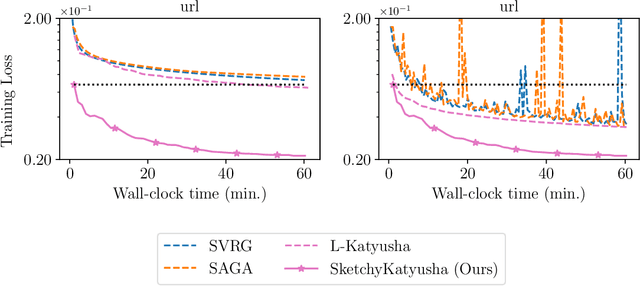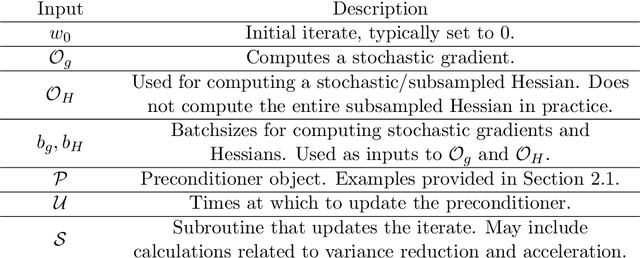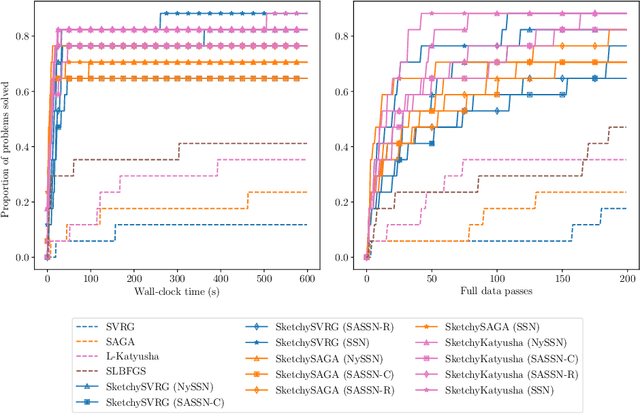Pratik Rathore
Turbocharging Gaussian Process Inference with Approximate Sketch-and-Project
May 19, 2025Abstract:Gaussian processes (GPs) play an essential role in biostatistics, scientific machine learning, and Bayesian optimization for their ability to provide probabilistic predictions and model uncertainty. However, GP inference struggles to scale to large datasets (which are common in modern applications), since it requires the solution of a linear system whose size scales quadratically with the number of samples in the dataset. We propose an approximate, distributed, accelerated sketch-and-project algorithm ($\texttt{ADASAP}$) for solving these linear systems, which improves scalability. We use the theory of determinantal point processes to show that the posterior mean induced by sketch-and-project rapidly converges to the true posterior mean. In particular, this yields the first efficient, condition number-free algorithm for estimating the posterior mean along the top spectral basis functions, showing that our approach is principled for GP inference. $\texttt{ADASAP}$ outperforms state-of-the-art solvers based on conjugate gradient and coordinate descent across several benchmark datasets and a large-scale Bayesian optimization task. Moreover, $\texttt{ADASAP}$ scales to a dataset with $> 3 \cdot 10^8$ samples, a feat which has not been accomplished in the literature.
Have ASkotch: Fast Methods for Large-scale, Memory-constrained Kernel Ridge Regression
Jul 14, 2024Abstract:Kernel ridge regression (KRR) is a fundamental computational tool, appearing in problems that range from computational chemistry to health analytics, with a particular interest due to its starring role in Gaussian process regression. However, it is challenging to scale KRR solvers to large datasets: with $n$ training points, a direct solver (i.e., Cholesky decomposition) uses $O(n^2)$ storage and $O(n^3)$ flops. Iterative methods for KRR, such as preconditioned conjugate gradient (PCG), avoid the cubic scaling of direct solvers and often use low-rank preconditioners; a rank $r$ preconditioner uses $O(rn)$ storage and each iteration requires $O(n^2)$ flops. To reduce the storage and iteration complexity of iterative solvers for KRR, we propose ASkotch ($\textbf{A}$ccelerated $\textbf{s}$calable $\textbf{k}$ernel $\textbf{o}$p$\textbf{t}$imization using block $\textbf{c}$oordinate descent with $\textbf{H}$essian preconditioning). For a given block size $|b| << n$, each iteration of ASkotch uses $O(r|b| + n)$ storage and $O(n|b|)$ flops, so ASkotch scales better than Cholesky decomposition and PCG. We prove that ASkotch obtains linear convergence to the optimum, with the convergence rate depending on the square roots of the $\textit{preconditioned}$ block condition numbers. Furthermore, we solve KRR problems that were considered to be impossibly large while using limited computational resources: we show that ASkotch outperforms PCG methods with respect to generalization error on large-scale KRR (up to $n = 10^8$) and KRR classification tasks (up to $n = 10^7$) while running each of our experiments on $\textit{a single 12 GB Titan V GPU}$. Our work opens up the possibility of as-yet-unimagined applications of KRR across a wide range of disciplines.
Challenges in Training PINNs: A Loss Landscape Perspective
Feb 02, 2024



Abstract:This paper explores challenges in training Physics-Informed Neural Networks (PINNs), emphasizing the role of the loss landscape in the training process. We examine difficulties in minimizing the PINN loss function, particularly due to ill-conditioning caused by differential operators in the residual term. We compare gradient-based optimizers Adam, L-BFGS, and their combination Adam+L-BFGS, showing the superiority of Adam+L-BFGS, and introduce a novel second-order optimizer, NysNewton-CG (NNCG), which significantly improves PINN performance. Theoretically, our work elucidates the connection between ill-conditioned differential operators and ill-conditioning in the PINN loss and shows the benefits of combining first- and second-order optimization methods. Our work presents valuable insights and more powerful optimization strategies for training PINNs, which could improve the utility of PINNs for solving difficult partial differential equations.
PROMISE: Preconditioned Stochastic Optimization Methods by Incorporating Scalable Curvature Estimates
Sep 15, 2023



Abstract:This paper introduces PROMISE ($\textbf{Pr}$econditioned Stochastic $\textbf{O}$ptimization $\textbf{M}$ethods by $\textbf{I}$ncorporating $\textbf{S}$calable Curvature $\textbf{E}$stimates), a suite of sketching-based preconditioned stochastic gradient algorithms for solving large-scale convex optimization problems arising in machine learning. PROMISE includes preconditioned versions of SVRG, SAGA, and Katyusha; each algorithm comes with a strong theoretical analysis and effective default hyperparameter values. In contrast, traditional stochastic gradient methods require careful hyperparameter tuning to succeed, and degrade in the presence of ill-conditioning, a ubiquitous phenomenon in machine learning. Empirically, we verify the superiority of the proposed algorithms by showing that, using default hyperparameter values, they outperform or match popular tuned stochastic gradient optimizers on a test bed of $51$ ridge and logistic regression problems assembled from benchmark machine learning repositories. On the theoretical side, this paper introduces the notion of quadratic regularity in order to establish linear convergence of all proposed methods even when the preconditioner is updated infrequently. The speed of linear convergence is determined by the quadratic regularity ratio, which often provides a tighter bound on the convergence rate compared to the condition number, both in theory and in practice, and explains the fast global linear convergence of the proposed methods.
SketchySGD: Reliable Stochastic Optimization via Robust Curvature Estimates
Dec 02, 2022Abstract:We introduce SketchySGD, a stochastic quasi-Newton method that uses sketching to approximate the curvature of the loss function. Quasi-Newton methods are among the most effective algorithms in traditional optimization, where they converge much faster than first-order methods such as SGD. However, for contemporary deep learning, quasi-Newton methods are considered inferior to first-order methods like SGD and Adam owing to higher per-iteration complexity and fragility due to inexact gradients. SketchySGD circumvents these issues by a novel combination of subsampling, randomized low-rank approximation, and dynamic regularization. In the convex case, we show SketchySGD with a fixed stepsize converges to a small ball around the optimum at a faster rate than SGD for ill-conditioned problems. In the non-convex case, SketchySGD converges linearly under two additional assumptions, interpolation and the Polyak-Lojaciewicz condition, the latter of which holds with high probability for wide neural networks. Numerical experiments on image and tabular data demonstrate the improved reliability and speed of SketchySGD for deep learning, compared to standard optimizers such as SGD and Adam and existing quasi-Newton methods.
 Add to Chrome
Add to Chrome Add to Firefox
Add to Firefox Add to Edge
Add to Edge